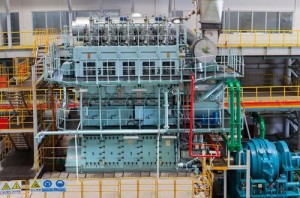 If a diesel engine installed on board a vessel has to be replaced by a non-identical diesel engine, the replacement engine has to comply with IMO Tier III emission regulations for installations after the 1 January 2016. The market is only starting to respond to this demand, and it may be difficult to find a suitable replacement engine complying with Tier III. DNV GL explains in this technical news how to handle this issue.
If a diesel engine installed on board a vessel has to be replaced by a non-identical diesel engine, the replacement engine has to comply with IMO Tier III emission regulations for installations after the 1 January 2016. The market is only starting to respond to this demand, and it may be difficult to find a suitable replacement engine complying with Tier III. DNV GL explains in this technical news how to handle this issue.
In case an IMO Tier III compliant engine is not available, DNV GL recommends:
Check if a Tier II engine could be allowed as an exception
MARPOL Annex VI allows the use of a Tier II replacement engine instead of a Tier III engine if certain criteria are met. In general, the criteria are related to the unavailability of a suitable engine with Tier III certification and, at the same time, to the nonfeasibility of retrofitting a Tier II engine due to various reasons related to engine performance, ship performance or ship safety.
Provide your reasons for not choosing a Tier III engine
Document the search for a Tier III engine and explain why the closest available engine with respect to size or performance is not appropriate for the ship. The search should also include engines produced by manufacturers other than the original engine’s manufacturer.
MARPOL Annex VI regulation provides for an exemption from IMO Tier III in regulation 13.2.2 if certain criteria are met. These criteria are listed in IMO MEPC.230(65):
- An engine with similar rating complying with Tier III is not commercially available.
- If a Tier II engine would have to be retrofitted with a NOxreducing device to meet Tier III, the NOx-reducing device cannot be installed on board due to size restrictions or due to the fact that extensive heat release could have an adverse impact whilst additional ventilation/insulation is not possible.
- A Tier III engine would not be a feasible replacement with regard to the ship’s characteristics such as drive shafts, reduction gears, cooling systems, exhaust and ventilation systems, and propeller shafts.
- A Tier III engine would not be a feasible replacement with regard to electrical systems for diesel generators (indirect drive systems), and other ancillary systems and ship equipment that would affect the choice of an engine.
- A Tier III engine would not be feasible concerning engine adjustment/ matching needed to meet boundary conditions and performance data necessary for SCR operation at all relevant load points.
- A Tier III engine would not be feasible in multi-engine (twin engine) arrangements where engines are installed as matched pairs (or more) as propulsion engines and where matching is necessary to ensure comparable manoeuvring.
- A Tier III engine would not be feasible because it would increase the ship’s electrical demand beyond the installed capacity.
- A Tier III engine would not be feasible because it would require modifications to the ship’s structure which would weaken its structural stability below the acceptable level.
- A Tier III engine would not be feasible because of other reasons stated by the ship owner and to be taken into consideration by the flag state administration. These reasons could be, for example, that the SCR device would require an excessive urea storage capacity relative to bunker capacity or that the SCR device is not to increase engine weight/volume by more than an unjustifiably low percentage.
The following reasons do not justify the use of a Tier II engine:
- Warranty period
- Life expectancy
- Cost
- Production lead time
 Ελληνικα
Ελληνικα